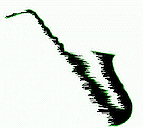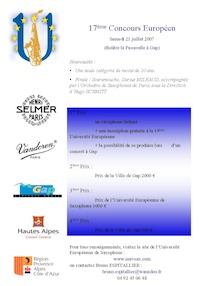New Review of Jazz Recording
Just added the first of what will be several reviews, of recordings or music.
In this case I'm talking about a Zoot Sims record which I just purchased: 'Hawthorn Nights'.
To read the review just follow this link:
Review: Hawthorn Nights [Original Jazz Classics, 2004]
European Competition for young sax players
I just received this announcement for a young players competition at Gap, France.
You can get further information by visiting their web site:
Notes flying off the page
Well, actually in this case, the notes are flying on the page.
Interesting youtube clip of John Coltrane's Giant Steps.
Trust me, it'll make your day.
http://www.youtube.com/watch?v=2kotK9FNEYU
Michael Brecker's last session
Just spotted this great promotion clip for the late Michael Brecker's last recording session which will be put out in Pilgrimage, which is set to be released in a few weeks.
Features interviews with the other artists who recorded the session which includes, Herbie Hancock, Pat Metheny, John Patitucci, Brad Mehldau and Jack DeJohnnette.
Worth a look-see.
ftp://telmedia.telarc.com/headsup/VIDEO/Pilgrimage/Brecker-Final-EPK.html
More details on the record is available on the Heads Up site. The page includes sound clips of the record.
http://headsup.com/albums/3095.asp
Saxo-trivia
Here's a little factoid, for you.
What do Ray Charles, Andrea Bocelli, David Bowie, Rudy Vallee and Lionel Richie have in common ?
Well of course, they're all singers !! That's too easy. Let's add these names to the list:
Bob Hope, Kareem Abdul-Jabbar, Bill Clinton.
You guessed it !
They have all played sax at some time in their lives. How cool is that. Not surprising tough, seen as the sax is such a cool instrument to play in the first place. But we already knew that, didn't we!
Let me know of any other famous saxophone amateurs.
R.I.P. Alvin Batiste
Just learned of the passing of clarinetist and sometimes saxophone player Alvin Batiste.
Among other things, he played with Ray Charles, Cannonball Adderley, Ornette Coleman, Ernie Wilkins and the Clarinet Summit.
Citing from the New York Times article:
"Mr. Batiste was born in New Orleans in 1932. He was considered one of the founders of the city’s modern jazz scene and wrote for and toured with Billy Cobham and Cannonball Adderley.
He was a longtime teacher at Southern University in Baton Rouge, La., where he created his own jazz institute, one of the first of its kind in the country; he also taught jazz at the New Orleans Center for Creative Arts. His students included Mr. Marsalis, Donald Harrison, Kent Jordan, Michael Ward, Herlin Riley, Charlie Singleton and Woodie Douglas."
LINK:
http://www.nytimes.com/2007/05/07/arts/07batiste.html?ref=music
Transcription Turn-around
As classical saxophonist all know, a lot of our upbringing has centered around the use of transcriptions. The sax being such a young instrument in the global history of music, the early pioneers had to create their own sources of material to perform. Even before being able to get composers to write new music for their instrument, they needed something to show off the capabilities of the saxophone. Hence the use and necessity of transcriptions.
My generation was brought up playing transcriptions by Marcel Mule , Sigurd Rascher or Larry Teal among others. I recall my first experience of playing in quartet reading Larry Teal's collection of 10 Saxophone Quartets or in a duet setting with his transcription of Bach's 2-part inventions. Mule's trancription of classical sonatas also come to mind.
These were necessary at the time to let young players get a taste of the masters and to have enough material to make an interesting program for concerts. There just wasn't a lot of original material available to us back then.
Flock to a sax quartet
An interesting concept for a saxophone quartet piece is what Jason Freeman of Georgia Tech is presently working on. His new work, Flock, is set to be previewed this week.
"Working with programmers, a computer vision expert and an adventurous saxophone quartet, Freeman is creating a work in which a restless audience is very literally part of the music. Listeners and musicians are encouraged to wander around the performance space during the concert, while digital cameras track their motion."
Read the full article at Wired.com.
Freeman also has a site discussing his work: http://music.columbia.edu/~jason/flock/
My little blurb for today
I don't have much time today, so I'll just mention that the Jacques Ibert's Concertino da Camera's first movement was premiered on this day, May 2, 1935 in Paris.
That's just a mere 72 years ago.

